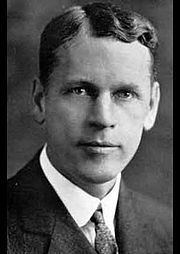Name Oswald Veblen Doctoral advisor E. H. Moore | Role Mathematician | |
 | ||
Born June 24, 1880Decorah, Iowa, U.S. ( 1880-06-24 ) Thesis A System of Axioms for Geometry (1903) Doctoral students J. W. AlexanderH. Roy BrahanaAlonzo ChurchPhilip FranklinHarold HotellingHoward H. MitchellRobert Lee MooreJ. H. C. Whitehead Books Projective Geometry, Introduction to infinitesi, Invariants of Quadratic, The Foundations of Differe, The Cambridge Colloquium Similar People E H Moore, James Waddell Alexande, John Wesley Young, Robert Lee Moore, J H C Whitehead | ||
George dyson on oswald veblen and the institute for advanced study
Oswald Veblen (June 24, 1880 – August 10, 1960) was an American mathematician, geometer and topologist, whose work found application in atomic physics and the theory of relativity. He proved the Jordan curve theorem in 1905; while this was long considered the first rigorous proof, many now also consider Jordan's original proof rigorous.
Contents
- George dyson on oswald veblen and the institute for advanced study
- Projective Geometry by Oswald Veblen
- Life
- Accomplishments
- Family
- Books by O Veblen
- References
Projective Geometry, by Oswald Veblen
Life
Veblen was born in Decorah, Iowa. He went to school in Iowa City. He did his undergraduate studies at the University of Iowa, where he received an A.B. in 1898, and Harvard University, where he was awarded a second B.A. in 1900. For his graduate studies, he went to study mathematics at the University of Chicago, where he obtained a Ph.D. in 1903. His dissertation, A System of Axioms for Geometry was written under the supervision of E. H. Moore.
Veblen taught mathematics at Princeton University from 1905 to 1932. In 1926, he was named Henry B. Fine Professor of Mathematics. In 1932, he helped organize the Institute for Advanced Study in Princeton, resigning his professorship to become the first professor at the Institute that same year. He kept his professorship at the Institute until he was made emeritus in 1950.
During his years in Princeton, Veblen and his wife Elizabeth accumulated land along the Princeton Ridge. In 1957 they donated 82 acres (33 ha) to establish the Herrontown Woods Arboretum, one of the largest nature preserves in Princeton, New Jersey.
Veblen died in Brooklin, Maine, in 1960 at age 80. After his death the American Mathematical Society created an award in his name, called the Oswald Veblen Prize in Geometry. It is awarded every three years, and is the most prestigious award in recognition of outstanding research in geometry.
Accomplishments
During his career, Veblen made important contributions in topology and in projective and differential geometries, including results important in modern physics. He introduced the Veblen axioms for projective geometry and proved the Veblen–Young theorem. He introduced the Veblen functions of ordinals and used an extension of them to define the small and large Veblen ordinals. In World War II he was involved in overseeing ballistics work at the Aberdeen Proving Grounds that involved early modern computing machines, in particular supporting the proposal for creation of the pioneering ENIAC electronic digital computer. He also published a paper in 1912 on the four-color conjecture.
Family
Veblen's uncle was Thorstein Veblen, noted economist and sociologist. Oswald Veblen's parents were Andrew Anderson Veblen and Kirsti Hougen.
